Deep Hybrid Model Based on EMD with Classification by Frequency Characteristics for Long-Term Air Quality Prediction
Abstract
1. Introduction
2. Related Works
- (1)
- After EMD, the obtained IMF components are further analyzed for their frequency characteristics, and all the components are divided into a fixed number of groups by convolutional neural network (CNN) networks. Different from [44,45,46], the fixed number can effectively solve the problem that a variable number of IMF components will be obtained when predicting different time intervals.
- (2)
- We present a general framework that predicts the PM2.5 data from air quality monitoring systems and obtains accurate long-term predictions that can meet the needs of precision in air quality warning.
3. Hybrid Deep Predictor
3.1. Decomposition and Analysis of PM2.5 Time Series
- (1)
- Identify the local maximum point of the given time series data and fit the maximum point with a cubic spline interpolation function to form an upper envelope of the original data.
- (2)
- Similarly, find the local minimum point of and fit all the minimum points through the cubic spline interpolation function to form the lower envelope of the original data.
- (3)
- Calculate the mean of the upper envelope and the lower envelope, denoted as .
- (4)
- Subtract the average of the envelope from the original data sequence to obtain a new data sequence : .
- (5)
- Repeat steps 1-4 with until one of the following stop criteria is met: ①, the preset maximum number of iterations is reached; ②, the last IMF separated is small; ③, the maximum or minimum value of the signal is less than 2; ④, is monotonic curve.
- (6)
- Treat as an IMF, and calculate the remainder .
- (7)
- Use as the new , and repeat steps (1)–(6) until all IMFs are obtained.
3.2. Classification and Combination for IMFs
3.3. Deep Prediction Network for Combined IMFs
3.4. Hybrid Model Framework
- (1)
- Decompose the data into IMFs by EMD and label each IMF into three groups based on its frequency characteristics as Group1–3.
- (2)
- Train the CNN by IMFs and labels, and add the sequences to each group.
- (3)
- Train GRU models for each group to get three GRU sub-predictors.
- (1)
- Decompose the input data into IMFs by EMD.
- (2)
- Use CNN to classify IMFs into three groups, and add the sequences of the same group together.
- (3)
- Use GRU models to obtain the predictions of all the groups.
- (4)
- Fuse all the predictions to obtain the integrated output of the original time series.
4. Experiment Results and Discussion
4.1. Dataset and Experimental Setup
4.2. Case 1: Prediction Performance Analysis of Different Predictor
4.3. Case 2: Prediction Performance Analysis of Different Combinations for IMFs
- (1)
- Mode No. 1: IMFs is divided into a group, i.e., {IMF 1–10}. Removing noise term, IMF0, others use one GRU to predict;
- (2)
- Mode No. 2: do not decompose the PM2.5 data, using one GRU for prediction;
- (3)
- Mode No. 3: IMFs is divided into two groups, i.e., {IMF 0}, {IMF 1–10}. Using two GRUs for two sub-sequences prediction separately;
- (4)
- Mode No. 4: IMFs is divided into two groups, i.e., {IMF 0–2}, {IMF 3–10}. Using two GRUs for two sub-sequences prediction separately;
- (5)
- Mode No. 5: IMFs is divided into three groups, i.e., {IMF 0–2}, {IMF 3–4}, {IMF 5–10}. Using three GRUs for three sub-sequences prediction separately;
- (6)
- Mode No. 6: IMFs is divided into four groups, i.e., {IMF 0–2}, {IMF 3–4}, {IMF 5–6}, {IMF 7–10}. Using four GRUs for four sub-sequences prediction separately;
- (7)
- Mode No. 7: IMFs is divided into five groups, i.e., {IMF 0}, {IMF 1–2} {IMF 3–4}, {IMF 5–6}, {IMF 7–10}. Using five GRUs for five sub-sequences prediction separately;
- (8)
- Mode No. 8: IMFs is divided into six groups, i.e., {IMF 0}, {IMF 1–2}, {IMF 3–4}, {IMF 5–6}, {IMF 7–8}, {IMF 9–10}. Using six GRUs for six sub-sequences prediction separately;
- (9)
- Mode No. 9: IMFs is divided into seven groups, i.e., {IMF 0}, {IMF 1–2}, {IMF 3}, {IMF 4}, {IMF 5–6}, {IMF 7–8}, {IMF 9–10}. Using seven GRUs for seven sub-sequences prediction separately.
- (10)
- Mode No. 10: IMFs is divided into eight groups, i.e., {IMF 0}, {IMF 1–2}, {IMF 3}, {IMF 4}, {IMF 5}, {IMF 6}, {IMF 7–8}, {IMF 9–10}. Using eight GRUs for eight sub-sequences prediction separately;
- (11)
- Mode No. 11: IMFs is divided into nine groups, i.e., {IMF 0}, {IMF 1–2}, {IMF 3}, {IMF 4}, {IMF 5}, {IMF 6}, {IMF 7}, {IMF 8}, {IMF 9–10}. Using nine GRUs for nine sub-sequences prediction separately;
- (12)
- Mode No. 12: IMFs is divided into ten groups, i.e., {IMF 0}, {IMF 1–2}, {IMF 3}, {IMF 4}, {IMF 5}, {IMF 6}, {IMF 7}, {IMF 8}, {IMF 9}, {IMF 10}. Using ten GRUs for ten sub-sequences prediction separately.
5. Conclusions
Author Contributions
Funding
Conflicts of Interest
References
- Xu, J.; Yang, W.; Han, B.; Wang, M.; Wang, Z.; Zhao, Z.; Bai, Z.; Vedal, S. An advanced spatio-temporal model for particulate matter and gaseous pollutants in Beijing, China. Atmos. Environ. 2019, 211, 120–127. [Google Scholar] [CrossRef]
- Di, Q.; Koutrakis, P.; Schwartz, J. A hybrid prediction model for PM2.5 mass and components using a chemical transport model and land use regression. Atmos. Environ. 2016, 131, 390–399. [Google Scholar] [CrossRef]
- Bai, Y.; Wang, W.; Jin, X.; Su, T.; Kong, J.; Zhang, B. Adaptive filtering for MEMS gyroscope with dynamic noise model. ISA Trans. 2020. [Google Scholar] [CrossRef] [PubMed]
- Benmouiza, K.; Cheknane, A. Small-scale solar radiation forecasting using ARMA and nonlinear autoregressive neural network models. Theor. Appl. Climatol. 2016, 124, 945–958. [Google Scholar] [CrossRef]
- Kocak, C. ARMA (p,q) type high order fuzzy time series forecast method based on fuzzy logic relations. Appl. Soft Comput. 2017, 58, 92–103. [Google Scholar] [CrossRef]
- Perez, E.G.; Ceballos, R.F. Malaria Incidence in the Philippines: Prediction using the Autoregressive Moving Average Models. Int. J. Eng. Future Tech. 2019, 16, 1–10. [Google Scholar] [CrossRef]
- Ruby-Figueroa, R.; Saavedra, J.; Bahamonde, N.; Cassano, A. Permeate flux prediction in the ultrafiltration of fruit juices by ARIMA models. J. Membr. Sci. 2017, 524, 108–116. [Google Scholar] [CrossRef]
- Aero, O.; Ogundipe, A. Fiscal Deficit and Economic Growth in Nigeria: Ascertaining a Feasible Threshold. Soc. Sci. Electr. Public 2018. Available online: https://ssrn.com/abstract=2861505 (accessed on 31 December 2016).
- Guo, H.; Pedrycz, W.; Liu, X. Hidden Markov Models-Based Approaches to Long-term Prediction for Granular Time Series. IEEE Trans. Fuzzy Syst. 2018, 26, 2807–2817. [Google Scholar] [CrossRef]
- Berrocal, V.J.; Guan, Y.; Muyskens, A.; Wang, H.; Reich, B.J.; Mulholland, J.A.; Chang, H.H. A comparison of statistical and machine learning methods for creating national daily maps of ambient PM2.5 concentration. Atmos. Environ. 2019, 222, 117130. [Google Scholar] [CrossRef]
- Ding, F.; Pan, J.; Alsaedi, A.; Hayat, T. Gradient-based iterative parameter estimation algorithms for dynamical systems from observation data. Mathematics 2019, 7, 428. [Google Scholar] [CrossRef]
- Ding, F.; Lv, L.; Pan, J.; Wan, X.; Jin, X.B. Two-stage gradient-based iterative estimation methods for controlled autoregressive systems using the measurement data. Int. J. Control Autom. Syst. 2020, 18. [Google Scholar] [CrossRef]
- Xu, L.; Ding, F. Iterative parameter estimation for signal models based on measured data. Circuits Syst. Signal Process. 2018, 37, 3046–3069. [Google Scholar] [CrossRef]
- Ding, J.; Chen, J.; Lin, J.X.; Wan, L.J. Particle filtering based parameter estimation for systems with output-error type model structures. J. Frankl. Inst. 2019, 356, 5521–5540. [Google Scholar] [CrossRef]
- Ding, F.; Xu, L.; Meng, D.; Jin, X.B.; Alsaedi, A.; Hayat, T. Gradient estimation algorithms for the parameter identification of bilinear systems using the auxiliary model. J. Comput. Appl. Math. 2020, 369, 112575. [Google Scholar] [CrossRef]
- Cui, T.; Ding, F.; Jin, X.B.; Alsaedi, A.; Hayat, T. Joint multi-innovation recursive extended least squares parameter and state estimation for a class of state-space systems. Int. J. Control Autom. Syst. 2020, 18. [Google Scholar] [CrossRef]
- Xu, L.; Xiong, W.L.; Alsaedi, A.; Hayat, T. Hierarchical parameter estimation for the frequency response based on the dynamical window data. Int. J. Control Autom. Syst. 2018, 16, 1756–1764. [Google Scholar] [CrossRef]
- Tang, C.H.; Coull, B.A.; Schwartz, J.; Di, Q.; Koutrakis, P. Trends and spatial patterns of fine-resolution aerosol optical depth–derived PM2.5 emissions in the Northeast United States from 2002 to 2013. J. Air Waste Manag. Assoc. 2017, 67, 64–74. [Google Scholar] [CrossRef]
- Oteros, J.; García-Mozo, H.; Hervás, C.; Galán, C. Bioweather and autoregressive indices for predicting olive pollen intensity. Int. J. Biometeorol. 2013, 57, 307–316. [Google Scholar] [CrossRef]
- Donnelly, A.; Misstear, B.; Broderick, B. Real time air quality forecasting using integrated parametric and non-parametric regression techniques. Atmos. Environ. 2015, 103, 53–65. [Google Scholar] [CrossRef]
- Bai, Y.T.; Wang, X.Y.; Jin, X.B.; Zhao, Z.Y.; Zhang, B.H. A neuron-based kalman filter with nonlinear autoregressive model. Sensor 2020, 20, 299. [Google Scholar] [CrossRef]
- Wang, L.; Zhang, T.; Wang, X.; Jin, X.; Xu, J.; Yu, J.; Zhang, H.; Zhao, Z. An approach of improved Multivariate Timing-Random Deep Belief Net modelling for algal bloom prediction. Biosyst. Eng. 2019, 177, 130–138. [Google Scholar] [CrossRef]
- Zhan, Y.; Luo, Y.; Deng, X.; Chen, H.; Grieneisen, M.L.; Shen, X.; Zhu, L.; Zhang, M. Spatiotemporal prediction of continuous daily PM2.5 concentrations across China using a spatially explicit machine learning algorithm. Atmos. Environ. 2017, 155, 129–139. [Google Scholar] [CrossRef]
- Wang, L.; Zhang, T.; Jin, X.; Xu, J.; Wang, X.; Zhang, H.; Yu, J.; Sun, Q.; Zhao, Z.; Xie, Y. An approach of recursive timing deep belief network for algal bloom forecasting. Neural Comput. Appl. 2020, 32, 163–171. [Google Scholar] [CrossRef]
- Ni, X.Y.; Huang, H.; Du, W.P. Relevance analysis and short-term prediction of PM 2.5 concentrations in Beijing based on multi-source data. Atmos. Environ. 2017, 150, 146–161. [Google Scholar] [CrossRef]
- Shang, Z.; Deng, T.; He, J.; Duan, X. A novel model for hourly PM2.5 concentration prediction based on CART and EELM. Sci. Total Environ. 2019, 651, 3043–3052. [Google Scholar] [CrossRef]
- Bai, Y.; Jin, X.; Wang, X. Compound Autoregressive Network for Prediction of Multivariate Time Series. Complexity 2019, 2019, 9107167. [Google Scholar] [CrossRef]
- Bai, Y.; Wang, X.; Sun, Q. Spatio-Temporal Prediction for the Monitoring-Blind Area of Industrial Atmosphere Based on the Fusion Network. Int. J. Environ. Res. Public Health 2019, 16, 3788. [Google Scholar] [CrossRef]
- Du, P.; Wang, J.; Hao, Y.; Niu, T.; Yang, W. A novel hybrid model based on multi-objective Harris hawks optimization algorithm for daily PM 2.5 and PM 10 forecasting 1 Introduction. Sci. Total Environ. 2019, 651, 1–24. [Google Scholar]
- Wang, Y.; Wang, Y.; Lui, Y.W. Generalized Recurrent Neural Network accommodating Dynamic Causal Modeling for functional MRI analysis. Neuroimage 2018, 178, 385–402. [Google Scholar] [CrossRef]
- Yadav, A.P.; Kumar, A.; Behera, L. RNN based solar radiation forecasting using adaptive learning rate. In International Conference on Swarm, Evolutionary, and Memetic Computing; Springer: Cham, Switzerland, 2013. [Google Scholar]
- Lin, H.; Shi, C.; Wang, B.; Chan, M.F.; Ji, W. Towards real-time respiratory motion prediction based on long short-term memory neural networks. Phys. Med. Biol. 2019, 64, 085010. [Google Scholar] [CrossRef]
- Zhang, D.; Lindholm, G.; Ratnaweera, H. Use long short-term memory to enhance Internet of Things for combined sewer overflow monitoring. J. Hydrol. 2018, 556, 409–418. [Google Scholar] [CrossRef]
- Rui, Z.; Wang, D.; Yan, R.; Mao, K.; Fei, S.; Wang, J. Machine Health Monitoring Using Local Feature-Based Gated Recurrent Unit Networks. IEEE Trans. Ind. Electron. 2017, 65, 1539–1548. [Google Scholar]
- Jin, X.B.; Yang, N.; Wang, X.; Bai, Y.; Su, T.; Kong, J. Integrated predictor based on decomposition mechanism for PM2.5 long-term prediction. Appl. Sci. 2019, 9, 4533. [Google Scholar] [CrossRef]
- Cheng, Y.; Zhang, H.; Liu, Z.; Chen, L.; Wang, P. Hybrid algorithm for short-term forecasting of PM2.5 in China. Atmos. Environ. 2019, 200, 264–279. [Google Scholar] [CrossRef]
- Liu, D.; Niu, D.; Wang, H.; Fan, L. Short-term wind speed forecasting using wavelet transform and support vector machines optimized by genetic algorithm. Renew. Energy 2014, 62, 592–597. [Google Scholar] [CrossRef]
- Rojo, J.; Rivero, R.; Romero-Morte, J.; Fernandez-González, F.; Perez-Badia, R. Modeling pollen time series using seasonal-trend decomposition procedure based on LOESS smoothing. Int. J. Biometeorol. 2017, 61, 335–348. [Google Scholar] [CrossRef]
- Xiong, T.; Li, C.; Bao, Y. Seasonal forecasting of agricultural commodity price using a hybrid STL and ELM method: Evidence from the vegetable market in China. Neurocomputing 2018, 275, 2831–2844. [Google Scholar] [CrossRef]
- Wang, Z.Y.; Qiu, J.; Li, F.F. Hybrid models combining EMD/EEMD and ARIMA for Long-term streamflow forecasting. Water 2018, 10, 853. [Google Scholar] [CrossRef]
- Yaslan, Y.; Bican, B. Empirical mode decomposition based denoising method with support vector regression for time series prediction: A case study for electricity load forecasting. Measurement 2017, 103, 52–61. [Google Scholar] [CrossRef]
- Kumar, S.; Panigrahy, D.; Sahu, P.K. Denoising of Electrocardiogram (ECG) signal by using empirical mode decomposition (EMD) with non-local mean (NLM) technique. Biocybern. Biomed. Eng. 2018, 38, 297–312. [Google Scholar] [CrossRef]
- Wang, J.; Wei, Q.; Zhao, L.; Tao, Y.; Rui, H. An improved empirical mode decomposition method using second generation wavelets interpolation. Digit. Signal Process. 2018, 79, 164–174. [Google Scholar] [CrossRef]
- Qiu, X.; Ren, Y.; Suganthan, P.N.; Amaratunga, G.A.J. Empirical Mode Decomposition based ensemble deep learning for load demand time series forecasting. Appl. Soft Comput. 2017, 54, 246–255. [Google Scholar] [CrossRef]
- Wang, J.; Tang, L.; Luo, Y.; Peng, G. A weighted EMD-based prediction model based on TOPSIS and feed forward neural network for noised time series. Knowl.-Based Syst. 2017, 132, S0950705117303027. [Google Scholar]
- Bedi, J.; Toshniwal, D. Empirical Mode Decomposition Based Deep Learning for Electricity Demand Forecasting. IEEE Access 2018, 6, 49144–49156. [Google Scholar] [CrossRef]
- Huang, N.E.; Shen, Z.; Long, S.R.; Wu, M.C.; Shih, H.H.; Zheng, Q.; Yen, N.C.; Chi, C.T.; Liu, H.H. The empirical mode decomposition and the Hilbert spectrum for nonlinear and non-stationary time series analysis. Proc. Math. Phys. Eng. Sci. 1998, 454, 903–995. [Google Scholar] [CrossRef]
- Salamon, J.; Bello, J.P. Deep convolutional neural networks and data augmentation for environmental sound classification. IEEE Signal Process. Lett. 2017, 24, 279–283. [Google Scholar] [CrossRef]
- Yang, W.; Zuo, W.; Cui, B. Detecting malicious URLs via a keyword-based convolutional gated-recurrent-unit neural network. IEEE Access 2019, 7, 29891–29900. [Google Scholar] [CrossRef]
- Zheng, Y.Y.; Kong, J.L.; Jin, X.B.; Wang, X.Y.; Su, T.L.; Zuo, M. Cropdeep: The crop vision dataset for deep-learning-based classification and detection in precision agriculture. Sensor 2019, 19, 1058. [Google Scholar] [CrossRef]
- Wang, Z.; Jin, X.; Wang, X.; Xu, J.; Bai, Y. Hard decision-based cooperative localization for wireless sensor networks. Sensor 2019, 19, 4665. [Google Scholar] [CrossRef]
- Wang, F.; Su, T.; Jin, X.; Zheng, Y.; Kong, J.; Bai, Y. Indoor Tracking by RFID Fusion with IMU Data. Asian J. Control 2019, 21, 1768–1777. [Google Scholar] [CrossRef]
- Wang, X.; Zhou, Y.; Zhao, Z.; Wang, L.; Xu, J.; Yu, J. A novel water quality mechanism modeling and eutrophication risk assessment method of lakes and reservoirs. Nonlinear Dyn. 2019, 96, 1037–1053. [Google Scholar] [CrossRef]
- Yu, J.; Deng, W.; Zhao, Z.; Wang, X.; Xu, J.; Wang, L.; Sun, Q.; Shen, Z. A hybrid path planning method for an unmanned cruise ship in water quality sampling. IEEE Access 2019, 7, 87127–87140. [Google Scholar] [CrossRef]
- Zhao, Z.; Yao, P.; Wang, X.; Xu, J.; Wang, L.; Yu, J. Reliable flight performance assessment of multirotor based on interacting multiple model particle filter and health degree. Chin. J. Aeronaut. 2019, 32, 444–453. [Google Scholar] [CrossRef]
- Wang, X.; Zhou, Y.; Zhao, Z.; Wei, W.; Li, W. Time-Delay System Control Based on an Integration of Active Disturbance Rejection and Modified Twice Optimal Control. IEEE Access 2019, 7, 130734–130744. [Google Scholar] [CrossRef]
- US Department of State - Mission China, Beijing. Available online: http://www.stateair.net/web/historical/1/1.html (accessed on 1 December 2019).

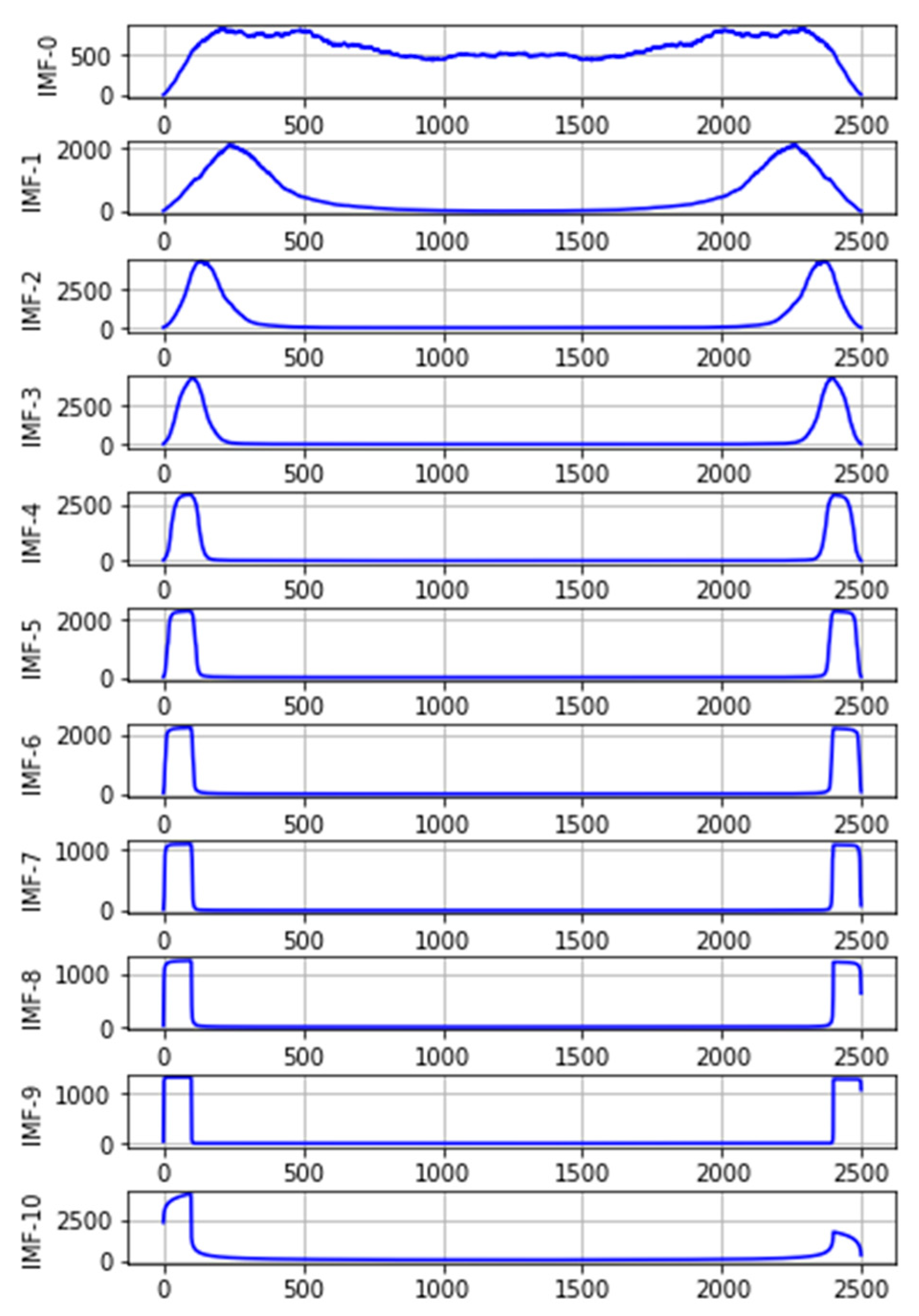
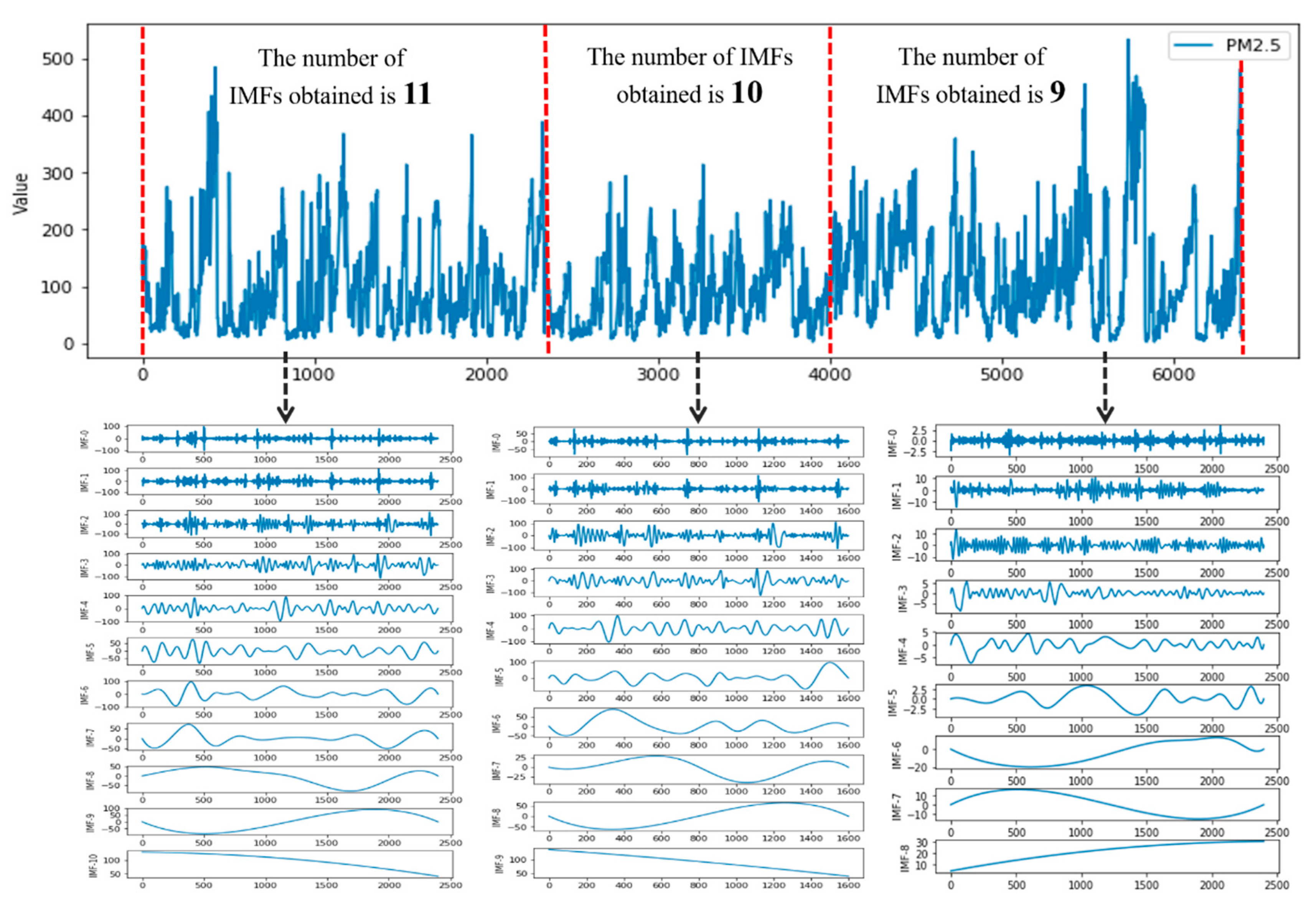
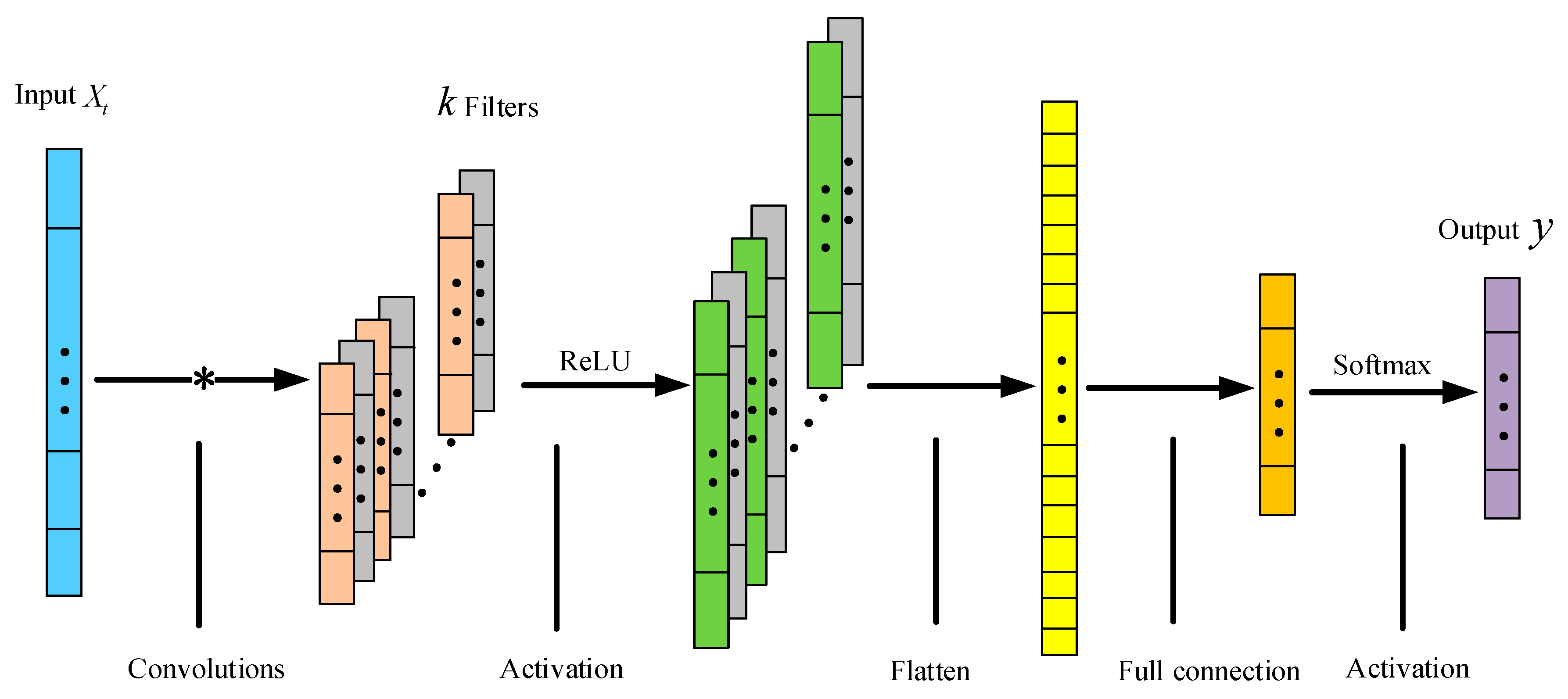
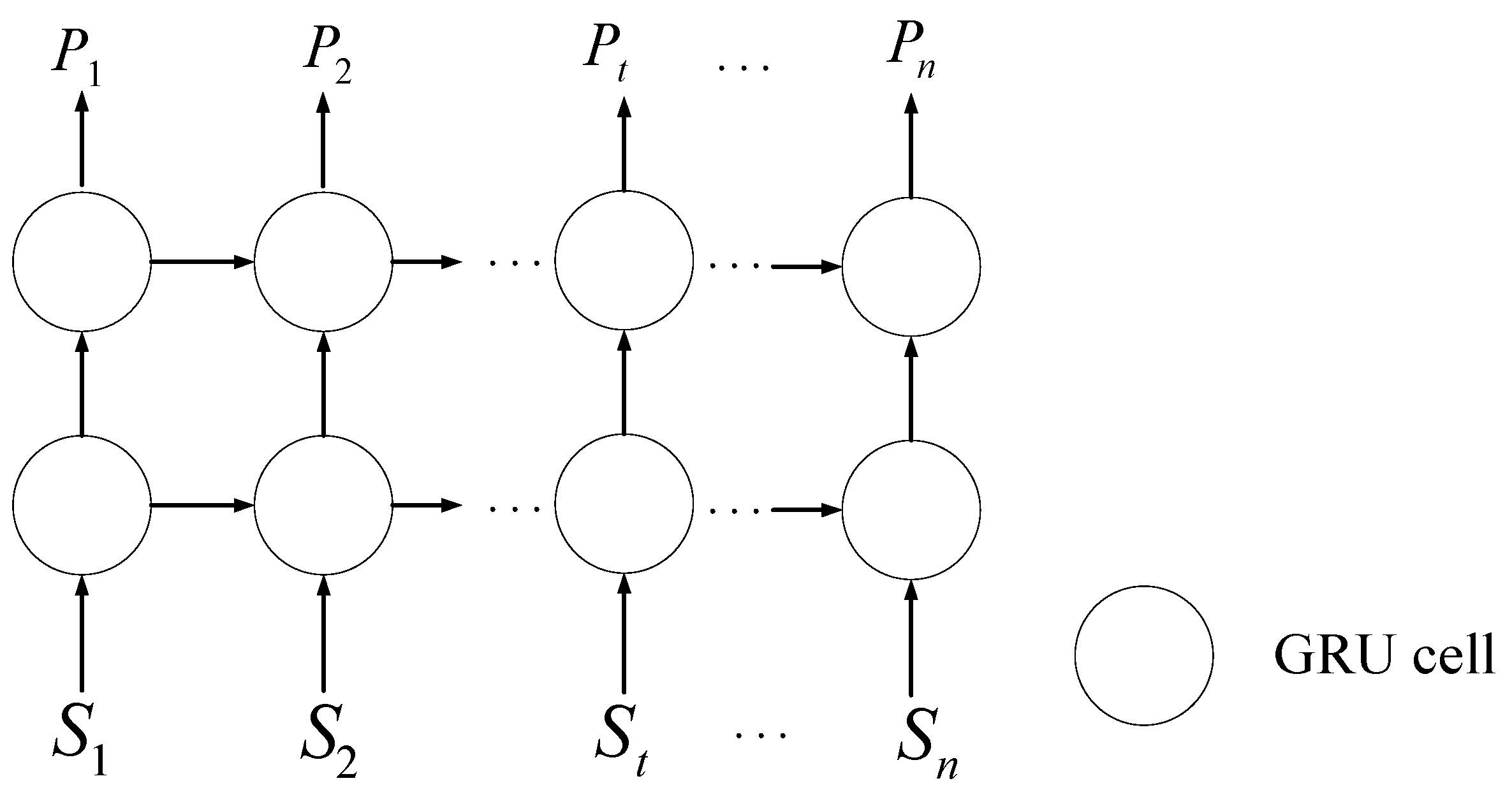
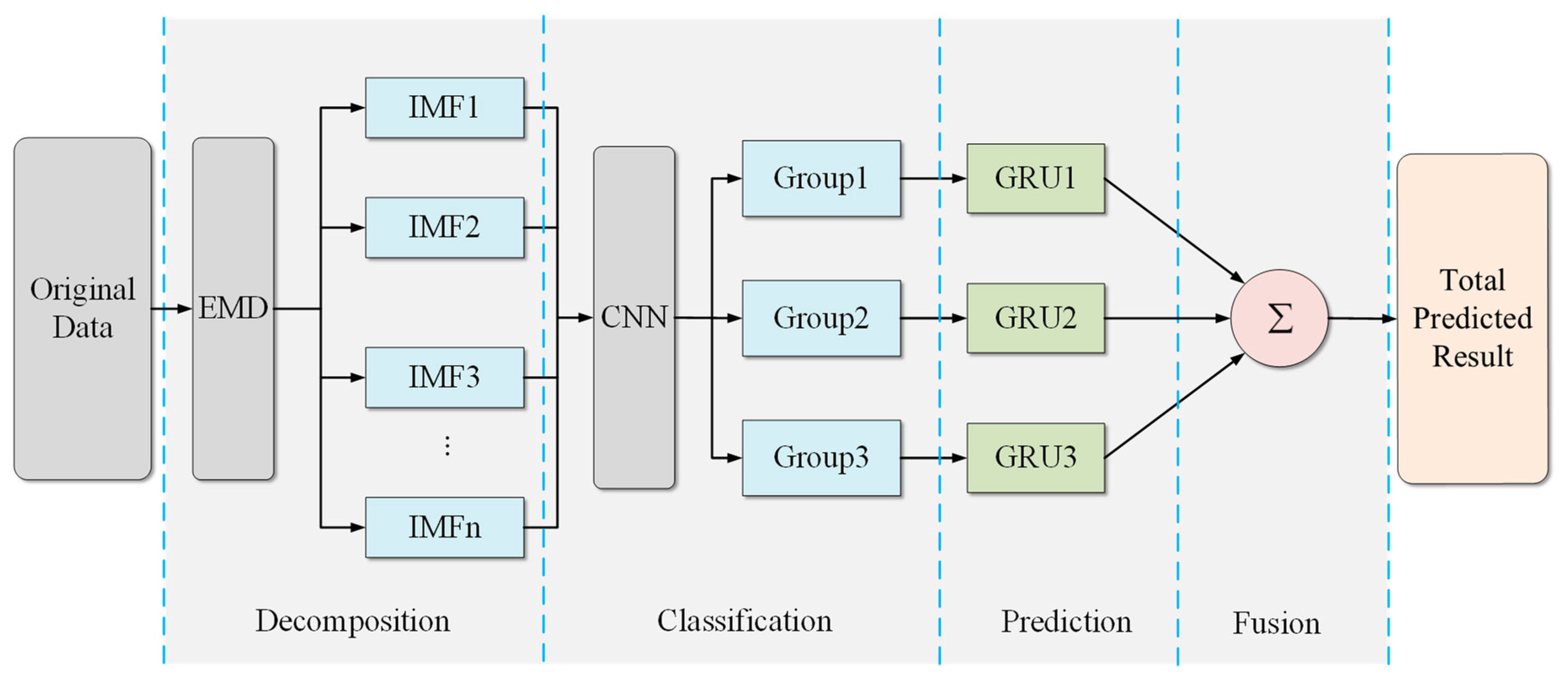


| Model | RMSE | NRMSE | MAE | SMAPE | R |
|---|---|---|---|---|---|
| RNN [31] | 64.0560 | 0.1817 | 48.7331 | 0.6256 | 0.6604 |
| LSTM [32] | 65.4283 | 0.2275 | 49.7205 | 0.5667 | 0.6426 |
| GRU [34] | 63.1271 | 0.2064 | 47.4970 | 0.5251 | 0.6523 |
| Decomposition-ARIMA -GRU-GRU [35] | 61.2917 | 0.1933 | 46.9718 | 0.5233 | 0.6508 |
| EMDCNN_RNN [31] | 54.5575 | 0.1632 | 41.8000 | 0.4918 | 0.7423 |
| EMDCNN_LSTM [32] | 51.1781 | 0.1394 | 40.9414 | 0.5100 | 0.7749 |
| The proposed method | 46.2619 | 0.1223 | 34.9598 | 0.4848 | 0.8185 |
| Combination Mode | Number of Groups | RMSE | NRMSE | MAE | SMAPE | R |
|---|---|---|---|---|---|---|
| Mode No. 1 | 1 group | 58.7715 | 0.1835 | 43.8560 | 0.4976 | 0.6792 |
| Mode No. 2 | 1 group | 63.1271 | 0.2064 | 47.4970 | 0.5251 | 0.6523 |
| Mode No. 3 | 2 groups | 59.6399 | 0.1823 | 44.0517 | 0.4942 | 0.6801 |
| Mode No. 4 | 2 groups | 87.2678 | 0.1415 | 54.2545 | 0.5964 | 0.5098 |
| Mode No. 5 | 3 groups | 46.2619 | 0.1223 | 34.9598 | 0.4848 | 0.8185 |
| Mode No. 6 | 4 groups | 46.0065 | 0.1109 | 34.7076 | 0.4432 | 0.8192 |
| Mode No. 7 | 5 groups | 45.0356 | 0.1001 | 33.6287 | 0.4318 | 0.8207 |
| Mode No. 8 | 6 groups | 48.3503 | 0.1333 | 37.0070 | 0.5336 | 0.8172 |
| Mode No. 9 | 7 groups | 48.0602 | 0.1281 | 35.8617 | 0.4978 | 0.8096 |
| Mode No. 10 | 8 groups | 51.8219 | 0.1155 | 38.0779 | 0.5009 | 0.7756 |
| Mode No.11 | 9 groups | 72.8165 | 0.1500 | 55.9136 | 0.8114 | 0.6812 |
| Mode No.12 | 10 groups | 52.2820 | 0.1298 | 39.2668 | 0.4800 | 0.7860 |
© 2020 by the authors. Licensee MDPI, Basel, Switzerland. This article is an open access article distributed under the terms and conditions of the Creative Commons Attribution (CC BY) license (http://creativecommons.org/licenses/by/4.0/).
Share and Cite
Jin, X.-B.; Yang, N.-X.; Wang, X.-Y.; Bai, Y.-T.; Su, T.-L.; Kong, J.-L. Deep Hybrid Model Based on EMD with Classification by Frequency Characteristics for Long-Term Air Quality Prediction. Mathematics 2020, 8, 214. https://doi.org/10.3390/math8020214
Jin X-B, Yang N-X, Wang X-Y, Bai Y-T, Su T-L, Kong J-L. Deep Hybrid Model Based on EMD with Classification by Frequency Characteristics for Long-Term Air Quality Prediction. Mathematics. 2020; 8(2):214. https://doi.org/10.3390/math8020214
Chicago/Turabian StyleJin, Xue-Bo, Nian-Xiang Yang, Xiao-Yi Wang, Yu-Ting Bai, Ting-Li Su, and Jian-Lei Kong. 2020. "Deep Hybrid Model Based on EMD with Classification by Frequency Characteristics for Long-Term Air Quality Prediction" Mathematics 8, no. 2: 214. https://doi.org/10.3390/math8020214
APA StyleJin, X.-B., Yang, N.-X., Wang, X.-Y., Bai, Y.-T., Su, T.-L., & Kong, J.-L. (2020). Deep Hybrid Model Based on EMD with Classification by Frequency Characteristics for Long-Term Air Quality Prediction. Mathematics, 8(2), 214. https://doi.org/10.3390/math8020214







